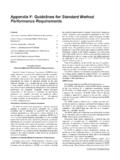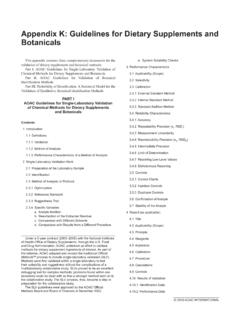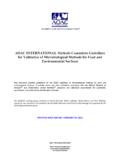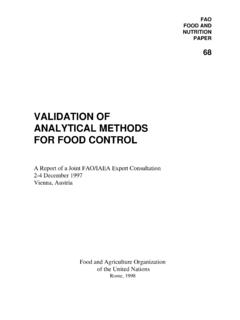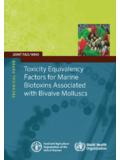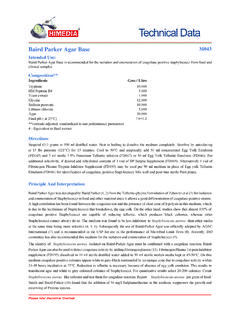Transcription of Appendix M: Validation Procedures for ... - AOAC International
1 2012 aoac INTERNATIONALA lthough there are a number of documents published on method Validation (1, 2) which target analytical methods in general, and there are numerous publications on Validation of ELISA methods for pesticides, these documents do not address specifi c areas of concern for food allergen analysis, such as reference materials, spiking methods , or choice of matrixes. In the absence of a universally recognized reference standard for food allergen ELISAs, many organizations and end-users use different Validation protocols and different analytical standards. Such inconsistency and duplication inevitably has a negative economic impact on the food allergen community. This document is designed to accompany the aoac Guidelines for Collaborative Study Procedures to Validate Characteristics of a Method of Analysis (1), and to provide guidance specifi c to the Validation of quantitative ELISA-based methods for food allergens.
2 This protocol was designed to meet or exceed the minimum requirements set forth in the aoac guidelines; it was developed with input from a wide range of experts in the area of food allergens, working under the auspices of the aoac Presidential Task Force on Food Allergens and with the active contribution of the Allergen Working Group, part of the MoniQA network of excellence. This document will focus on developing guidance on a method Validation study protocol to validate the performance characteristics of quantitative food allergen ELISA methods . The practical protocol is intended to help method developers in designing a study to generate appropriate Validation data that would be suitable for submission to aoac International or regulatory bodies for recognition.
3 Both the study design and data would be subject to scrutiny before acceptance by the aoac or other for detecting various food allergens have been available for a number of years. Many of these methods use ELISA-based techniques to detect specifi c protein markers in food matrixes. The detection of food allergens by ELISA is a unique analytical procedure characterized by the recognition and binding of specifi c antigens by antibodies. Food allergens are proteins, which are large and complex molecules with defi ned structures in their native forms, that can induce allergic reactions in sensitized consumers. From the analytical point of view, the integrity of the protein structure is critical to favor protein solubility and promote antibody-allergen binding.
4 Although specifi city of antibodies in commercial ELISAs for food allergens varies, in most cases, these methods target a complex mixture of soluble allergenic and nonallergenic proteins, rather than a specifi c protein. This mixture of target proteins will have diverse structural and chemical properties in the complex mixture of a food matrix. Some food commodities contain several allergenic proteins, , at least eight peanut proteins, such as Ara h 1 and Ara h 2, can potentially cause an immunological response. But other commodities, such as fi sh, shellfi sh, and mollusks, contain only one major allergen; still others may consist mainly of allergenic proteins, , all major milk proteins (caseins, -lactoglobulin, -lactalbumin, etc.)
5 Possess an allergenic ability of an ELISA method to detect food allergen proteins in a test sample is affected by the effi ciency with which these proteins are extracted from the sample, as well as the effi ciency with which the antibody or antibodies used in the ELISA detect these proteins in the sample extract. The overall performance of an ELISA-based method for the detection of food allergens is a function of these two fact that allergic individuals often react to different protein constituents of the allergenic food further complicates the choice of targets. Because most food products are heat-treated, food production processes like roasting and extrusion can have signifi cant infl uence on the solubility and extractability of the target proteins, as well as on the ability of the antibody or antibodies used in the ELISA to recognize them.
6 Factors that may infl uence the test results include: (1) interactions with compounds in a food matrix ( , polyphenols and tannins); (2) reduced solubility and reactivity of heat-denatured proteins; and (3) differences in the protein profi le of a particular food allergen from different species, varieties, and geographic origins. These factors all contribute to the diffi culty in fi nding appropriate reference materials for food allergens and explaining why the proteins in a sample extract might not be fully comparable to that of the calibrators included with a particular detection method. These topics have been extensively reviewed recently (3).Availability of validated methods is critical for both method developers and end-users.
7 For method developers, Validation of an analytical procedure is used to demonstrate that it is suitable for its Appendix M: Validation Procedures for Quantitative Food Allergen ELISA methods : Community Guidance and Best PracticesThis document provides supplemental guidance on specifi cations for the development and implementation of studies to validate the performance characteristics of quantitative ELISA methods for the determination of food allergens. It is intended as a companion document to other existing publications on method Validation . The guidance is divided into two sections: information to be provided by the method developer on various characteristics of the method, and implementation of a multilaboratory Validation study. Certain criteria included in the guidance are allergen-specifi c.
8 Two food allergens, egg and milk, are used to demonstrate the criteria guidance. These recommendations will be the basis of the harmonized Validation protocol for any food allergen ELISA method, whether proprietary or nonproprietary, that will be submitted to aoac and/or regulatory authorities or other bodies for status recognition. Regulatory authorities may have their own particular requirements for data packages in addition to the guidance in this document. Future work planned for the implementation and Validation of this guidance will include guidance specifi c to other priority guidance and best practices were completed by the aoac Food Allergens Analytical Community and submitted to aoac International for publication in : Abbott, M., Hayward, S., Ross, W., Godefroy, , Ulberth, F., Van Hengel, , Roberts, J.
9 , Akiyama, H., Popping, B., Yeung, , Wehling, P., Taylor, S., Poms, , & Delahaut, P. (2010) J. aoac Int. 93, 442 450 2012 aoac INTERNATIONALFOOD ALLERGEN COMMUNITY GUIDANCE aoac OFFICIAL methods OF ANALYSIS (2012) Appendix M, p. 2intended purpose. For end-users, validated methods help to ensure reliability, repeatability, accuracy, and precision of the results generated using a particular performance is documented using information and data provided by the method developer through interlaboratory Validation studies. Minimum requirements for both information and data are included in this guidance, and may be applicable to any priority food allergen, as defi ned by the Codex Alimentarius Committee on Food Labeling in 1998 (4).
10 However, due to the nature of food allergens, certain aspects, such as reference materials and spiking methods , would need to be addressed on a case-by-case basis. This document addresses these allergen-specifi c criteria for two food allergens, egg and milk. Further guidance for other priority allergens will be developed and communicated by the aoac Presidential Task Force on Food Allergens and/or the Food Allergens Analytical Community under the auspices of the MoniQA Allergen-Specifi c Information to be Provided on the ELISA Method Information relating to the design of a method and its target analytes, as well as method performance characteristics, shall be provided by the method developer when submitting Validation data for assessment.
